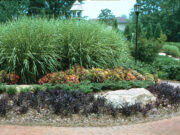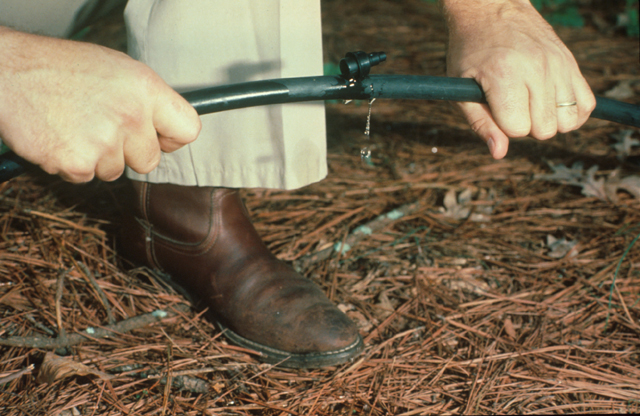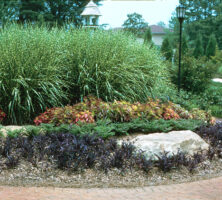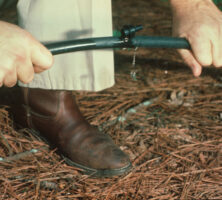Xeriscape (pronounced “zera-scape”), a term coined in Colorado in 1981, is loosely defined as a water-conserving method of landscaping in dry climates. Xeriscape gardening refers to a seven-step approach to conserving landscape water without sacrificing environmental quality. Its importance in Georgia has increased as water shortages and restrictions on outdoor water use have become more common and population growth has placed increasing strain on available water supplies. Between 1990 and 2000, Georgia’s population grew by 20 percent, and the majority of these new residents migrated to urban areas. By 2000 more than half of Georgia’s 8.1 million residents lived in just 15 of the state’s 159 counties. Not only are there more people competing for water resources in urban areas, but periodic drought during the growing season increases the demand for municipal water as citizens turn on irrigation systems to keep their lawns green and their plants healthy.
During the summer months, when citizens irrigate their yards and gardens, residential water use typically increases between 40 and 60 percent. Unfortunately, much of the water applied to landscapes is used unnecessarily to irrigate drought-tolerant plants that do not need supplemental water. Millions of gallons of water could be saved each year if citizens learned how to water, when to water, the most efficient methods of applying water, and the water requirements of lawns and landscape plants.
The seven steps to Xeriscape gardening include proper planning and design, soil analysis, appropriate plant selection, practical turf areas, efficient irrigation, the use of mulches, and appropriate maintenance. The more thoroughly these steps are implemented, the more water-efficient a landscape will become. The Xeriscape concept has been adopted by states throughout the nation, including Georgia, and has been modified to fit local climate and soil conditions.
Proper Planning and Design
Proper planning and design are important, both for designing a new landscape and for adding to an existing landscape. When possible, incorporate existing native vegetation into the landscape. Native areas left undisturbed generally require no supplemental irrigation. When designing new areas, divide the landscape into three water-use zones: high, moderate, and low. High-water-use zones are small, highly visible areas of the landscape where plants are watered routinely for optimum growth. Plants in the moderate-water-use zone are watered only when they show visible signs of stress, such as wilted foliage and off-green color, while plants in the low-water-use zone are provided no supplemental irrigation once established. Ideally, 10 percent or less of the total landscape area should be zoned for high water use, not more than 30 percent should be moderate water use, and 60 percent or more should be zoned for low water use.
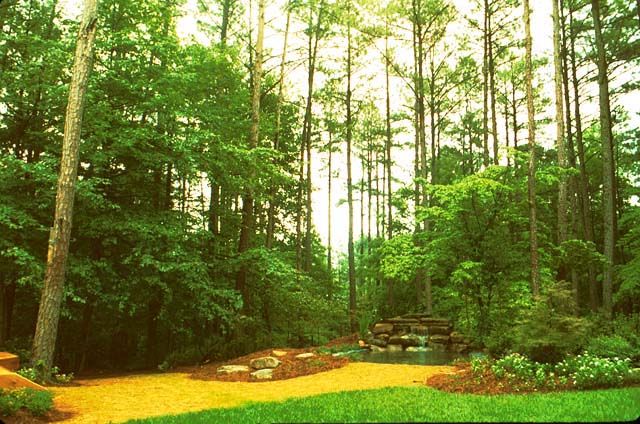
Photograph by Gary L. Wade
Soil Analysis
Soil analysis is critical to optimize the soil’s water-holding capacity, yet provide good drainage. Organic amendments, for example compost, benefit most soils. It is recommended that four inches of an organic material be applied to the soil surface and incorporated into the top twelve inches.
Appropriate Plant Selection
Appropriate plant selection is important to any landscape, but it has particular importance in a Xeriscape. Select plants that are adapted to the site conditions and plant them in the appropriate water-use zones. Any plant in the nursery trade can be used in a Xeriscape, provided it is zoned according to the amount of water the established plant will require.
Practical Turf Areas
Practical turf areas emphasize the use of turfgrass for its function in the landscape, such as for erosion control or as a recreational surface. Avoid using large expanses of irrigated turfgrass just to fill space in the landscape. When selecting turfgrasses, consider their ability to withstand hot, dry periods in summer.
Efficient Irrigation
Efficient irrigation makes every drop count. By irrigating between 9 p.m. and 9 a.m., less evaporative water loss occurs than in the hot mid-day sun. Water also can be saved by resetting the irrigation time clock regularly according to changes in rainfall patterns and by installing a rainfall sensor to prevent the irrigation system from operating during rain. Drip irrigation and hand watering help target irrigation to plants that need it.
Use of Mulches
The use of mulches helps conserve water in the soil and insulates the roots of plants from extreme heat in summer and cold in winter. Mulches also reduce soil-borne foliar diseases by acting as a barrier between the soil and the foliage. Such organic mulches as pine straw, pine bark, and shredded hardwood bark are excellent mulch choices.
Appropriate Maintenance
Appropriate maintenance is critical once the other water-saving steps are in place. Reduce the amount of fertilizer applied, particularly during dry periods, and minimize summer pruning that encourages new, succulent growth, which has a high demand for water. Grasscycling, the practice of leaving grass clippings on the turf area instead of bagging them, adds moisture and nutrients back to the turf and conserves moisture by acting as a mulch at the base of the grass blades.

Photograph by Gary L. Wade
Xeriscape gardening is a practical, common-sense approach to quality landscapes that conserves water and protects the environment. It is a beautiful way to have twice the landscape for half the water.


